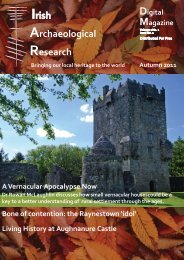Irish Archaeological Research Digital Magazine
Irish Archaeological Research Digital Magazine
Irish Archaeological Research Digital Magazine
Create successful ePaper yourself
Turn your PDF publications into a flip-book with our unique Google optimized e-Paper software.
As with all previous conferences, the 2012 meeting was hosted by an academic institution, in this case the<br />
Archaeology Department of York University, which is situated in the beautiful late medieval Kings Manor building<br />
just outside the historic city walls. This academic context led to a predominance of papers discussing scientific<br />
experiments, with nine out of twelve presentations taking this approach. The standard of these was generally<br />
high: of particular note was Spiteri’s work on recreating residues on prehistoric cooking pots, which argued that<br />
vegetable residues were unlikely to survive even if extensively used, and Chu and Thompson’s innovative<br />
abrasion of lithics within an annular flume to demonstrate no macro‐ or micro‐scopic difference between the<br />
abrasion of bedded or free‐moving flints in fluvial systems.<br />
<strong>Irish</strong> <strong>Archaeological</strong> <strong>Research</strong> Issue 2 Jan 2012<br />
Whilst there were some commercial archaeologists and museum professionals among those attending the<br />
conference, most attendees were academics. As a result the two final papers by Fillery‐Travis and Wood, raising<br />
the issues of defining who we consider to be experimental archaeologists and how we measure the impact and<br />
engagement with our discipline respectively, produced limited debate. It was disappointing that although<br />
practical demonstrations were a feature of the second day, there were few craftspeople formally present at the<br />
conference as attendees. Their involvement in discussions would have brought wider perspectives to the<br />
debate, and better contextualised some of the work presented.<br />
Despite these limitations the meeting stands out amongst many archaeology conferences for the enthusiastic<br />
and approachable nature of its attendees, and the open and un‐bureaucratic nature of its organisation. The<br />
welcoming nature of the conference is a direct reflection of the vibrant nature of the experimental archaeology<br />
community, with many new friendships made over a pint in the evening. Following the success of this 6th<br />
edition of the conference, myself and colleague set up a website to archive abstracts and posters from the<br />
series, and to act as a portal for news on the upcoming 7th conference (http://experimentalarchaeology.org.uk/).<br />
Anyone interested in the conference or the type of work undertaken by experimental archaeologists is<br />
encouraged to visit, and feedback is gratefully received.<br />
It is hoped that those papers from the 6th Conference reporting scientific work will be published as a special<br />
addition of the Springer journal <strong>Archaeological</strong> and Anthropological Sciences in December 2012, and that we will<br />
see a 7th Conference, possibly in Cardiff, before January 2013. This conference is not limited to British<br />
contributors and represents a fantastic opportunity for practitioners and archaeologists of all kinds to<br />
communicate their work to a wider audience and see examples of what experimental archaeologists are<br />
currently working on. I recommend anyone, whatever methodology they utilise, to consider submitting an<br />
abstract at the next call for papers. It is my personal hope that the growing profile of the conference will<br />
encourage experimenters from outside academia to attend, and the conference itself will continue to expand<br />
and embrace a wider audience.<br />
40



